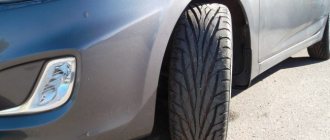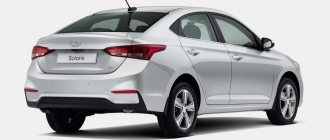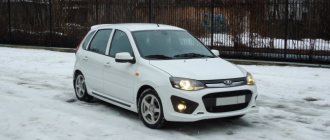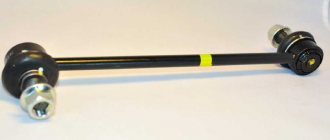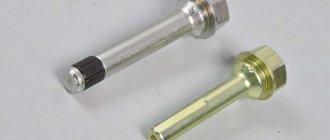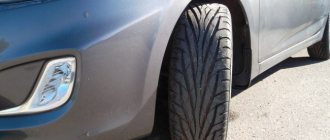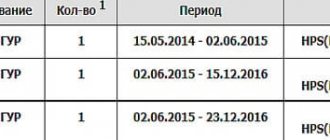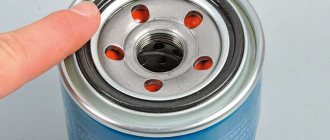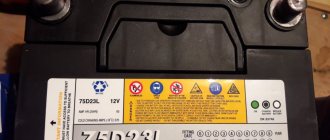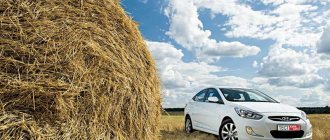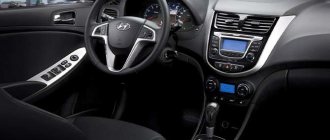Hyundai Solaris is a passenger car from the South Korean concern Hyundai Motors. Solaris is made on a platform basis from Hyundai Accent. The model is of high quality, well built, adapted for domestic roads.
Since its debut, two generations of Hyundai Solaris have been released:
- First: 2011-2017;
- Second: 2022 – present.
In addition to two generations, intermediate restyled versions were released: 2011 - 2016. There are no fundamental differences between the modifications, but with some features that you need to know about.
Hyundai Solaris I 2013 1.4i
Generation: I Engine: I4, Gasoline Power: 107 hp
(79 kW) Wheel bolt pattern parameters
| PCD (number of holes x circle diameter) | 4×100 mm |
| Center Hole Diameter (DIA) | 54.1 mm |
| Fasteners | M12 x 1.5 |
| Type of fastener | screw |
| Tires | Discs | PCD | Dia | Pressure |
| 175/70 R14 84T Factory kit | 5.5Jx14ET43 | 4×100 | 54.1 | 2.3 |
| 185/65 R15 88T Tuning | 6Jx15 ET48 | 4×100 | 54.1 | 2.3 |
| 195/50 R16 84H Tuning | 6Jx16 ET52 | 4×100 | 54.1 | 2.3 |
| 195/55 R16 87T Tuning | 4×100 | 54.1 | 2.3 |
What wheel sizes does the manufacturer recommend to install?
The Hyundai Solaris I 2013 1.4i is equipped with 5.5Jx14 ET43 rims and 175/70 R14 84T tires as standard. Where:
- 5.5J - rim width in inches;
- 14″ — tire diameter in inches;
- ET43 - disc offset in millimeters.
The vehicle tire marking 175/70 R14 is deciphered as follows:
- 175 — profile width (cross section of the tire) in millimeters;
- 70 - profile height as a percentage of its width;
- R - radial cord winding;
- 14 is the tire diameter in inches.
In addition, information about its load capacity and speed parameters can be printed on the rubber - load index and speed index. The load index is a two- or three-digit number; the speed index is indicated in Latin letters, for example 84T:
- 84 - maximum permissible tire load 500 kg;
- T — maximum permissible vehicle speed is 190 km/h.
Using the recommended tire sizes will help you avoid problems with handling, safety and other difficulties. What non-standard sizes can be supplied? Refer to the table; it indicates possible acceptable alternative sizes for tuning. Although there are other options that we have not described in the table. For example, wider discs of the same diameter. Or install wheels of the same width, but with a larger diameter, which is quite popular among car owners. The choice of discs is huge; you can find copies with the same parameters, but with an overhang 1-2 millimeters more or less. It is not possible to list all the options.
At the same time, the bolt pattern for all types of wheels is the same - 4x100. Thus, all disks are mounted with four bolts and the distance between them is exactly one hundred millimeters. The car's hub diameter is 54.1 mm.
Standard tire pressure is 2.3 MPa.
Answers (2)
16-inch wheels are installed from the factory on Solaris in the maximum configuration. These wheels look very cool and harmonious.
Factory tire size: 195 / 55 / R16. I recommend setting these parameters - this is the ideal size:
Disc: bolt pattern - 4X100, width - 6J, 6.5J permissible, offset - ET48-52, slight deviation permissible, hub diameter - CO 54.1 mm, take the disc no smaller than this hole, otherwise it simply won’t fit, if it is larger, then you can solve problem with centering rings.
You should not install tires measuring 205/55 R16 - the Solaris will look awkward on them, and these tires will extend beyond the arches, thereby sand and dirt will dirty the car faster.
The Russians saw the first Solaris, assembled in St. Petersburg by Hyundai Motor, a subsidiary of Hyundai Motor Company, in 2011. And I must say, it became a good competitor for the then popular Renault Logan and VW Polo.
The Hyundai Getz was no less in demand, but it was discontinued so as not to create competition between models of the same brand.
As soon as the new car went on sale, wheels for the Hyundai Solaris (meaning the size) immediately became scarce due to the sharp rise in demand. What was the reason for this, and what range of tires and wheels are offered for this car today? You will learn about this and much more from this article.
Hyundai Solaris I 2013 1.6i
Generation: I Engine: I4, Gasoline Power: 122 hp (90 kW)
Wheel bolt pattern parameters
| PCD (number of holes x circle diameter) | 4×100 mm |
| Center Hole Diameter (DIA) | 54.1 mm |
| Fasteners | M12 x 1.5 |
| Type of fastener | screw |
| Tires | Discs | PCD | Dia | Pressure |
| 175/70 R14 84T Factory kit | 5.5Jx14ET43 | 4×100 | 54.1 | 2.3 |
| 185/65 R15 88T Tuning | 6Jx15 ET48 | 4×100 | 54.1 | 2.3 |
| 195/50 R16 84H Tuning | 6Jx16 ET52 | 4×100 | 54.1 | 2.3 |
| 195/55 R16 87T Tuning | 4×100 | 54.1 | 2.3 | |
| 205/45 R17 Tuning | 6.5Jx17 ET43 | 4×100 | 54.1 | 2.3 |
What wheel sizes does the manufacturer recommend to install?
The Hyundai Solaris I 2013 1.6i is equipped with 5.5Jx14 ET43 rims and 175/70 R14 84T tires as standard. Where:
- 5.5J - rim width in inches;
- 14″ — tire diameter in inches;
- ET43 - disc offset in millimeters.
The vehicle tire marking 175/70 R14 is deciphered as follows:
- 175 — profile width (cross section of the tire) in millimeters;
- 70 - profile height as a percentage of its width;
- R - radial cord winding;
- 14 is the tire diameter in inches.
In addition, information about its load capacity and speed parameters can be printed on the rubber - load index and speed index. The load index is a two- or three-digit number; the speed index is indicated in Latin letters, for example 84T:
- 84 - maximum permissible tire load 500 kg;
- T — maximum permissible vehicle speed is 190 km/h.
What is the effect of installing non-standard dimensions on the Hyundai Solaris?
The size of wheels, tires, disks that are installed on a car have a direct impact on its technical characteristics. In the instruction manual, the manufacturer indicates recommended and acceptable sizes.
The owner of a Hyundai Solaris independently decides what type and size of wheels and tires to install. For a driver who uses the car as a means of transportation, the factory rim sizes are more than enough.
In case of tuning, changes in standard characteristics, dynamic indicators, it is necessary to refit the car with non-standard wheel sizes.
List of characteristics that can be changed by installing non-standard wheel sizes:
- Controllability;
- Road grip;
- Sharp and responsive steering wheel;
- Reduced (increased) aquaplaning;
- Comfort of movement;
- Noise level;
- Combined cycle fuel consumption;
- Tread wear rate.
General background information
Ranges of possible values for tires and wheels Hyundai Solaris 2013.
Tires
| Diameter | 14″–17″ |
| Width (mm) | 175–205 |
| Profile (%) | 45–70 |
| The smallest size | 175/70 R14 |
| The biggest size | 205/45 R17 |
Wheel disks
| Diameter | 14″–17″ |
| Width (inches) | 5.5–6.5 |
| Reach (mm) | 43–52 |
| Drills | 4×100 |
Expert advice
When choosing tires for a car, you must first follow the manufacturer's instructions. Ask yourself a few questions.
- On what roads will the car be primarily used?
- Do you need increased cross-country ability?
- How much of the route will be city roads and how much will be highways?
- Will the vehicle carry heavy loads?
The answers to these and similar questions will help determine which tire parameters you need to pay special attention to.
How to choose the right wheels for Hyundai Solaris 2013?
- Stamped (economical price category) - made from a sheet of iron by stamping on a press.
- Light alloy - manufactured by casting (more reliable than stamped ones).
- Forged (the highest quality and more expensive than the previous ones) - made from light alloys by stamping at high temperatures.
The choice depends on financial capabilities. However, it should be borne in mind that the quality of the road surface on which you have to drive every day must also be taken into account.
So, if it gets into a hole, a stamped disk will bend and will not cause harm to the tire, but a forged or cast one can cut it. There is a possibility that the cast disc may burst or crack.
It should also be noted that repairing “stamping” wheels is cheaper than repairing cast or forged wheels. But wheels with high-quality cast and forged disks kill the suspension less, because lighter and have more perfect geometry (better balanced).
The same wheels may or may not rub with tires on the same car - wheel alignment adjustment will help here.
What is the tire pressure?
It is the driver's responsibility to constantly monitor tire pressure. This will avoid standard problems associated with vehicle operation. An abnormal pressure value often causes:
- deterioration of management;
- uneven tread wear.
Often the car owner independently reduces the pressure in the wheels of his own vehicle. This reduces the load on the suspension, and the car “passes” various road irregularities an order of magnitude easier. But it is worth noting: a decrease in pressure even by 0.1 MPa leads to serious problems. The main ones include:
- increased fuel consumption;
- rapid wear of the outer tread segments;
- the car becomes less maneuverable.
An overinflated wheel causes no less problems. The central part of the cylinder begins to wear off quickly. In addition, at ambient temperatures of more than 60 degrees Celsius, the tire may simply explode. Which will lead to driving into the oncoming lane.
Recommendations for disc care
- Check the geometry and wheel balancing on a special diagnostic stand. If deviations are detected, restore the integrity of the structure at a service station. It is impossible to “reanimate” the disk on your own due to the lack of necessary equipment;
- Immediately contact a service station for preventive maintenance if you find cracks or dents on the rim;
- Avoid getting into potholes, especially at high and medium speeds. The disk will be deformed, the seal will be broken, regardless of the material of manufacture;
- Monitor the tire pressure; it should not differ from that recommended by the manufacturer. If there is a deviation, pump it up yourself, contact the service station;
- Observe the transition to summer and winter modes. In summer, the tire pressure is 0.15 atm higher, in winter it is lower by the same amount. The parameters are specified in the vehicle operating instructions;
- Tighten the rim nuts with a torque wrench. Excessive tightening contributes to the breakage of the studs, weak - to the unscrewing of the wheel and a collision on the road.
In sunny weather, cast aluminum wheels are least susceptible to external damage. But in slush, ice, when the road is strewn with various chemicals, the rim is susceptible to corrosion. This provokes paint peeling and destruction of the molecular composition.
Wash your wheels as they get dirty. Since it is unlikely that you can clean it properly with a rag, use high-pressure compressors. Equipment of this class is available at many service stations, workshops, and service centers.
Systematic polishing allows you to get rid of scratches and burrs. First clean the wheel from dirt, dry it thoroughly, and then treat it with a chemical. Wipe several times with a microfiber cloth.
Store wheels in a hanging position, do not stack them on top of each other. Clean off any dirt, dry, and wrap in cellophane. Some motorists practice applying an aerosol to the surface before preservation. However, this is a purely personal decision of the owner.
The average service life of original wheels is 150 – 180 thousand km. Subject to a moderate driving style, the replacement interval will increase by a third. The service life of tires is half as long as disks.
Select your Solaris 1.4i I release year
The Hyundai Solaris 1.4i I model was produced from 2011 to 2013. Table of factory and suitable tire sizes for Hyundai Solaris 1.4i I.
| Make model modification Auto | Year of issue | Width, profile, tire radius | type of instalation |
| Hyundai Solaris 1.4i I | 2013 | 175/70 R14 | Factory |
| Hyundai Solaris 1.4i I | 185/65 R15 | Acceptable | |
| Hyundai Solaris 1.4i I | 195/50 R16 | Acceptable | |
| Hyundai Solaris 1.4i I | 195/55 R16 | Acceptable | |
| Hyundai Solaris 1.4i I | 2012 | 175/70 R14 | Factory |
| Hyundai Solaris 1.4i I | 185/65 R15 | Acceptable | |
| Hyundai Solaris 1.4i I | 195/50 R16 | Acceptable | |
| Hyundai Solaris 1.4i I | 195/55 R16 | Acceptable | |
| Hyundai Solaris 1.4i I | 2011 | 175/70 R14 | Factory |
| Hyundai Solaris 1.4i I | 185/65 R15 | Acceptable | |
| Hyundai Solaris 1.4i I | 195/50 R16 | Acceptable | |
| Hyundai Solaris 1.4i I | 195/55 R16 | Acceptable |
Despite the fact that this information is taken from the websites of auto manufacturers, our catalog is for informational purposes only and does not guarantee full compliance of the proposed sizes with your car.
Source
How the pressure sensor works, how to turn it off
Starting from the second generation, Hyundai Solaris is equipped with electronic tire pressure sensors. The first generation has mechanical sensors. Due to insufficient efficiency and information content, the latter were replaced by modern ones.
The main task of the digital gadget is to monitor changes in air pressure in the tire and transmit data online to the electronic control unit. The latter compares the indicators with the programmed ones and informs the driver about a possible malfunction. Most often, this is a sound signal combined with light flickering.
Standard wheel sizes for Hyundai Solaris 2013, 1.6i I
Table of parameters and wheel bolt patterns for Hyundai Solaris 1.6i I - 2013 model. Minimum and maximum sizes of standard disks for Hyundai Solaris 1.6i I - 2013.
Disc drilling parameters are usually called bolt pattern:
- LZ (number of holes)
- PCD (hole center circle diameter)
- ET (disc offset)
- DIA (hole diameter)
| Make model modification Auto | Year of issue | Options | Disc width | Disc diameter | Bolt pattern LZ*PCD | Departure ET | Diameter DIA | type of instalation |
| Hyundai Solaris 1.6i I | 2013 | 5.5Jx14 4/100 ET43 d54.1 | 5.5 | 14 | 4X100 | 43 | 54.1 | Factory |
| Hyundai Solaris 1.6i I | 6Jx15 4/100 ET48 d54.1 | 6 | 15 | 4X100 | 48 | 54.1 | Acceptable | |
| Hyundai Solaris 1.6i I | 6Jx16 4/100 ET52 d54.1 | 6 | 16 | 4X100 | 52 | 54.1 | Acceptable | |
| Hyundai Solaris 1.6i I | 6.5Jx16 4/100 ET43 d54.1 | 6.5 | 16 | 4X100 | 43 | 54.1 | Acceptable | |
| Hyundai Solaris 1.6i I | 6.5Jx17 4/100 ET43 d54.1 | 6.5 | 17 | 4X100 | 43 | 54.1 | Acceptable |
Despite the fact that this information is taken from the websites of auto manufacturers, our catalog is for informational purposes only and does not guarantee full compliance of the proposed sizes with your car.
Source
Tires, wheels for Hyundai Solaris
For owners of cars with any mileage, questions about maintaining their vehicle are relevant. Drivers who carefully search for answers to them protect themselves from unnecessary expenses, getting uninterrupted operation and high performance of the car.
Tires for Hyundai Solaris are a popular product, especially in the off-season. The optimal selection of tires for this car will lead not only to driving comfort and giving an individual appearance, but also to increased handling, improved speed characteristics and an increase in the service life of the chassis.
What tire and wheel sizes are recommended by KOLOBOX for Hyundai Solaris?
The size of tires and wheels depends on two indicators of the Hyundai Solaris car:
Let's look at the wheel and tire sizes that KOLOBOX recommends for this car, relative to the above parameters:
| Hyundai Solaris; Year of manufacture 01/01/2010-01/01/2017; Modification I | |||
| R15 | |||
| Tires | Discs | ||
| Original | 185/65R15 | Original | 6×15 4*100 d54-54.1 ET48 |
| Replacement | 195/60R15 | Replacement | 5-7×15 4*100 d54-100 ET20-52 |
| R16 | |||
| Tires | Discs | ||
| Original | 195/55R16 | Original | 6×16 4*100 d54-54.1 ET52 |
| Replacement | 205/50R16 | Replacement | 6-8×16 4*100 d54-100 ET20-52 |
| Hyundai Solaris; Year of manufacture 01/01/2017 -; Modification II | |||
| R15 | |||
| Tires | Discs | ||
| Original | 185/65R15 | Original | 6×15 4*100 d54-54.1 ET46-48 |
| Replacement | 195/60R15 | Replacement | 5-7×15 4*100 d54-100 ET20-52 |
| R16 | |||
| Tires | Discs | ||
| Original | 195/55R16 | Original | 6×16 4*100 d54-54.1 ET49-52 |
| Replacement | 205/50R16 | Replacement | 6-8×16 4*100 d54-100 ET20-52 |
According to the manufacturer's data, tires for Solaris must meet the markings 185/65R15 or 195/55R16. Based on the formulas, the smallest tire width is 185, and the largest is 195 (mm). At the minimum value, the tire height to width ratio is 65 percent, with a rim diameter of 15 inches. At the maximum value, the profile height to width ratio is 55 percent, the rim diameter is 16
What tires are suitable for a Hyundai Solaris car in the winter?
Winter tire sets must have a high degree of grip to resist icy and snowy roads. Deep grooves and strong studs provide reliable driving in winter. Let's consider the possible options for winter tires for the Hyundai Solaris:
| Winter tires for Hyundai Solaris | Bridgestone Ice Cruiser 7000S Pirelli Ice Zero Pirelli Ice Zero Friction Pirelli Winter Snow Control Pirelli Winter Cinturato Maxxis NP3 Arctic Trekker Maxxis SP3 Premitra Ice BFGoodrich G-Force Stud BFGoodrich G-Force Winter 2 Michelin X-Ice North 4 Nokian Nordman 5 Nokian Nordman RS2 Nokian Nordman 7 Nokian Hakkapeliitta R3 Goodyear Ultra Grip 600 Michelin X-Ice 3 HYPERLINK |
The recommended maximum load for the tires listed above depends on their size and ranges from 545 kg (weight index 87) to 630 kg (weight index 92). The speed indicator that is achieved under different loads is marked Q (speed value equal to 160 km per hour), S (speed value equal to 160 km per hour) and maximum T for them (speed value equal to 190 km per hour).
At maximum speed, Nokian and Michelin tires can withstand the greatest load that is permissible for them.
What tires are suitable for a Hyundai Solaris in the summer?
The highest load and dimensional values of summer tire sets on Hyundai correspond to winter tires. The difference lies in the speed index. Summer tire sets for Solaris have a maximum load value that does not have a negative impact between 560 kg and 630 kg. The speed indicators that the car will reach are 190-210 km per hour. The tire is 185 mm wide, 15 inches in diameter, and has a height-to-diameter ratio of 65 percent.
If the tire formula looks like 195/55R16, then the maximum permissible load that they can withstand at a speed of 240 km per hour is less than 545 kg.
What wheels are recommended for a Hyundai Solaris?
Suitable disk sizes for Solaris are as follows: 15x5.5J, 15x6J, 16x6J. The Latin letter J is a designation of the design type of disk flange that specialists refer to. For drivers, the important values are the diameter and width, which are indicated in the above formulas.
The next important disc value for a Hyundai Solaris car is its offset, which is marked as ET. For this machine it varies from 46 to 52 mm. The offset can deviate from this value by no more than 7 mm, because a significant deviation leads to deterioration in handling and reduced wear resistance of the suspension.
Tire quality
In addition to the size of the rims, bolt pattern, type of tires and other things, there are still important points that you should pay attention to when choosing wheels. This is the quality of rubber for Hyundai Solaris. Of course, it is more difficult to determine it by appearance, but you can use information from manufacturers and benefit from the experience of other motorists. In general, tire quality will affect the following indicators:
- Braking efficiency;
- Controllability;
- Comfort when driving;
- The durability of the tires themselves.
At the factory, new cars are equipped with Kumho Solus or Hankook Optima tires. This is an inexpensive Korean-made tire that nevertheless meets modern requirements for road grip, durability and noise level. Such wheels can be safely installed after the factory set has worn out; their characteristics are sufficient for comfortable movement in city conditions. They have good ability to drain water when driving in wet weather, and also have good speed and weight indexes with a reserve for this car. On the highway, under normal conditions, in compliance with the permitted speed limits, they also do not cause any complaints.
Fans of dynamic driving with sharp accelerations and the same pressure on the brake pedal in difficult road situations may need wider rubber capabilities and improved performance. They should consider options like the Hankook Tire Optimo K406 88H (up to 210 km/h), Continental ContiPremiumContact 2, Dunlop SP Sport FastResponse 88V (up to 240 km/h) or something like that. These tires are significantly more expensive, but are much better suited for high speed loads and braking. Naturally, the choice of good wheels for Solaris is not limited to these brands; in this price segment there are a large number of excellent offers from various world-famous manufacturers, including Nokian, Bridgestone, Yokohama, Pirelli and others.
There are also less expensive options to refit your car, and they are quite suitable for those drivers whose priorities are not speed performance, but price and normal overall performance are more important. Examples of such tires include Dunlop SP Touring T1, Viatti Strada Assimetrico V-130, Cordiant Sport W1 for summer, Viatti Brina V-521, Cordiant Polar 2, Dunlop SP Winter Sport 400 and others for winter.
